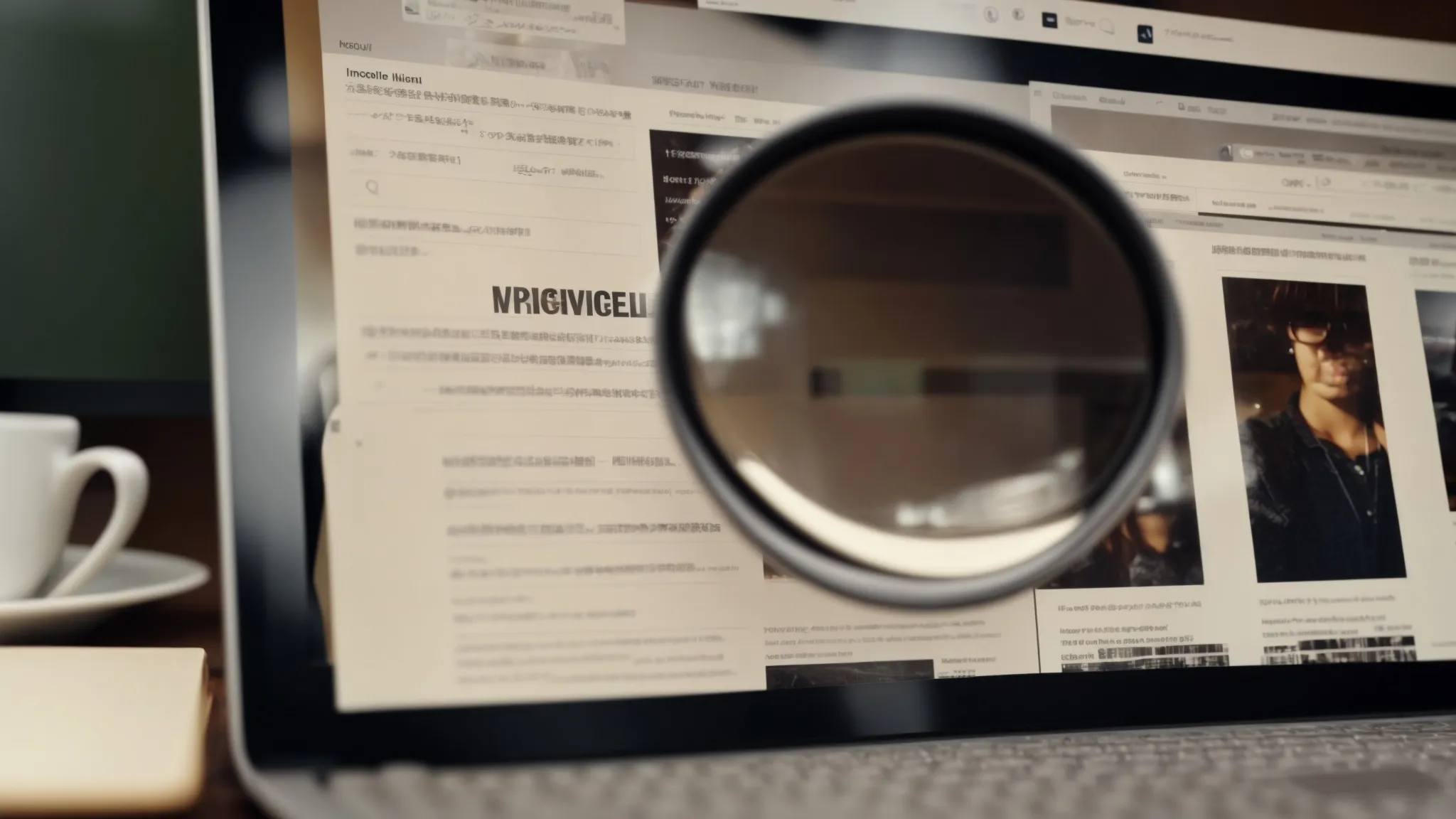Mastering Canonical Tags for Improved SEO Performance
In search engine optimization, the canonical tag emerges as a sign of order, guiding search engines through the maze of duplicate content to the most authoritative version of a web page.
Far from being a mere line of code, the canonical tag operates as an invisible steward, influencing the flow of PageRank and crafting a user's journey with surgical precision.
By leveraging the subtle power of these HTML elements, webmasters can fortify their site’s structure, speak in the language of search engines, and ensure that their most valuable content shines on the search engine results page.
Missteps in the use of canonical tags are like setting sail without a compass, where the risk of lost traffic and diluted rankings looms large.
Unfurl the map to mastering canonical tags and chart a course to improved SEO performance.
Key Takeaways
- Canonical tags guide search engines to the preferred page, affecting visibility and authority.
- Proper implementation and auditing of canonical tags are crucial for SEO effectiveness.
- Misuse of canonical tags can lead to diminished search presence and diluted authority.
- Beyond preventing duplicate content, canonical tags also enhance site navigation and user experience.
- Anticipating future changes in SEO, like AI and algorithm updates, is vital for maintaining an effective strategy.
Understanding the Role of Canonical Tags in SEO

In the intricacy of search engine optimization, the canonical tag serves as a guiding light, steering web pages toward the coveted territory of search engine results page (SERP) dominance.
Far from being a mere piece of HTML ornamentation, a canonical tag holds formidable clout in clarifying the waters muddled by duplicate content, effectively whispering to search engines the pages to favor.
It is not an exaggeration to acclaim that understanding the SEO valor of canonical tags is similar to wielding a master key for digital marketers as they sculpt their website's architecture.
The dance of algorithms and rankings heeds the subtle lead of canonical tags, influencing the spotlight of visibility each web page garners.
Delve deeper into the purpose behind this pivotal tag and observe its impact on the grand stage of search engine standings.
Defining Canonical Tags and Their SEO Value
In digital marketing, a canonical tag emerges as the unsung hero—an essential yet often overlooked protagonist in the narrative of search engine optimization. Embodied within a line of code, this HTML element graciously informs search engines which version of a page is the definitive one, an authoritative source to be indexed, thus mitigating the perplexity of duplicate content.
This solid tag weaves a thread of clarity through a website's intricate tapestry, guiding Google's algorithms with the precision of a seasoned conductor. By implementing the canonical link element, webmasters orchestrate a symphony of web pages, ensuring that only the most relevant crescendos reach the audience on the coveted stage of the search engine results page.
The Impact of Canonical Tags on Search Engine Rankings
The subtle art of deploying canonical tags can be equated to setting the sails for a vessel navigating the tumultuous seas of search rankings. When correctly anchored within the source code of a website's page, these potent tags act as unerring compass points, guiding the search engine's bots toward the most relevant and original content, thereby bolstering the page's authority and potential to ascend the ranks.
By resolving the riddle of duplicate content, canonical tags whisper secrets into the search engine's ear, favoring the original draft in the library of web pages. This favor, in turn, can translate to a stronger PageRank for the chosen piece, granting it priority in the grand performance that unfolds upon the digital stage of a user's query. This enhances the overall user experience and solidifies the website's stature in the search engine's script.
How to Effectively Use Canonical Tags

Navigating through the digital wilderness, a website owner encounters many crossroads—one such juncture is the strategic implementation of canonical tags for SEO refinement.
Grasping the intricacies of canonicalization demands more than mere awareness; it requires a detailed blueprint that directs embedding these directives within the HTML framework.
What follows is a concise guide, meticulously delineating the steps to embed canonical tags correctly, rendering them effective sentries against the mire of duplicate content.
Similarly, it unveils the fine craft of utilizing canonical tags across pages with closely related content, ensuring that the narrative of each page is harmoniously woven into the fabric of search engine algorithms and enhancing the digital reality of internet users seeking information.
Steps to Correctly Implement Canonical Tags on Your Website
The deployment of canonical tags commences with a selection process like anointing a king among peers; one must designate the preferred URL as the canonical version within the website's ecosystem. This involves adding the “” element to the section of the duplicate or similar pages, clearly signaling to search engines the primary source to be displayed in search results.
After embedding the canonical link tag, vigilant monitoring and assessment are imperative to ensure it functions as intended. Managers must analyze the website's analytics, tracking the performance and influence of the canonicalized pages on SERP positioning. One should look for improvements in rankings and user experience metrics and ensure there are no unintended consequences, such as decreased visibility or traffic to the canonical page.
Tips for Using Canonical Tags on Similar Content Pages
In the alchemy of digital landscapes, where similar content pages might inadvertently dilute the essence of a website's message, the strategic application of canonical tags comes to the rescue by judiciously selecting the page that holds the core narrative—the one that the site owner wishes to be the touchstone of a particular subject—canonical tags ensure that multiple pages with overlapping themes reinforce, rather than cannibalize, their SEO potency.
Further refining the craft, it's crucial that the designated page, honored with the canonical link, serves as the central hub of information, echoing the promise of quality and relevance to users and crawlers. Such methodical consolidation under the auspices of a single URL exemplifies best practice and keeps the integrity of the site's thematic structure intact, affirming its command over the subject matter in the eyes of search engines.
Avoiding Common Canonical Tag Mistakes

The judicious use of canonical tags is pivotal in search engine optimization, yet missteps are common even among the most seasoned webmasters.
It is critical to discern and rectify these misapplications to ensure that they do not undermine a website's pursuit of SERP supremacy.
By scrutinizing real-world examples where canonical tags have been misappropriated, invaluable insights are gleaned, steering clear of the pitfalls that could jeopardize a website’s SEO journey.
This cautionary tale unfolds through case studies illustrating the errors that should be meticulously avoided and serves as a litmus test for the health and efficacy of a site's canonical strategy.
Identifying and Correcting Frequent Errors With Canonical Tags
In the quest to perfect one's digital domain, vigilance against canonical tag misuse is as critical as the shield of a seasoned warrior. When web pages are inaccurately flagged with non-canonical URLs, the resultant discord can skew the symphony of search engine rankings, causing the true champions of content to fade into obscurity.
Rectifying such errors starts with a meticulous audit, where each canonical meta tag is scrupulously reviewed to ensure it points to the most authoritative version of the content. Correcting the course requires updating the canonical link element to reflect the correct URL, thus restoring order and clarity within the search engine's perspective and bolstering the website's SEO stance.
Case Studies: What Not to Do With Canonical Tags
When one examines the annals of canonical misadventures, a recurring theme emerges from the archives of digital marketing mishaps—improper use of the canonical tag in pagination. An illuminative case study reveals a website where a sequence of paginated content was led astray, with each page erroneously pointing to the first in the series as the canonical source, thereby obscuring the rich, unique content of subsequent pages from the discerning eyes of search engines, and diminishing the site’s overall reach.
Another cautionary example unravels from the misconfigured canonicals in multilingual websites. The cornerstone of this case is a site that implemented hreflang tags without synchronizing them with the appropriate canonical URLs, inadvertently creating a Babylon of conflicting signals to search engines. This oversight fragmented the site's authority, causing a schism in ranking strength, which could have been avoided with a harmonious alignment of canonical and hreflang directives, quintessential for a unified, SEO-strong international presence.
Canonical Tags vs. 301 Redirects: When to Use Each

As architects of the digital world discern the appropriate tools for constructing a seamless user journey, the distinction between the use of canonical tags and 301 redirects becomes a crucial decision point.
While both are essential for directing traffic and managing content visibility, they serve divergent roles, like a compass and a crossroads on the traveler's map of the internet.
In the following discourse, the nuances distinguishing these two navigational aids are unraveled, pinpointing the practical scenarios in which the judicious application of canonical tags is favored over the permanence of 301 redirects. This ensures that a website's landscape's structural integrity and SEO fortitude are meticulously maintained.
Understanding the Difference Between Canonical Tags and 301 Redirects
Grasping the subtleties that distinguish canonical tags from 301 redirects is a refined skill like a strategist discerning between a scalpel and a sword: both are instruments of change, yet their applications vary greatly. Canonical tags function as gentle guides, informing search engines of the preferred URL for content that appears in multiple locations, harmonizing the presence of similar pages without rerouting the visitor.
Conversely, 301 redirects act as the decisive turn in the road, permanently redirecting users and search engines from one URL to another, thereby signaling that the original page has been moved or replaced. This irreversible step is a proclamation that the former URL has relinquished its relevance in favor of a new destination:
- Canonical tags subtly signal search engine preference while preserving the current structure of a website.
- 301 redirects serve as a permanent guide, rerouting traffic and seemingly erasing the existence of the old URL in the digital echelon.
Practical Scenarios for Choosing Canonical Tags Over Redirects
In the theater of digital marketing, there are moments when the use of canonical tags is the director's choice over the finality of 301 redirects. Take, for instance, a series of seasonal product pages with content that shifts like the phases of the moon yet remains thematically consistent; here, canonical tags shine by highlighting the most relevant page without ushering older versions offstage.
Moving through the ever-shifting sands of search engine optimization, another scenario emerges where the elegance of canonical tags is preferred to redirect's resolute cut. When A/B tests different landing page designs to gauge user experience, employing canonical tags allows data collection to sail smoothly across variant shores without the disruptive riptides caused by the more drastic 301 redirects.
Auditing Your Canonical Tags for Better SEO Outcomes

In the meticulous journey of search engine optimization, auditing the use of canonical tags emerges as a defining maneuver in fortifying a website's online presence.
This systematic examination paves the way for pinpointing inefficiencies and capitalizing on opportunities to enhance the search engine’s understanding of site content.
To navigate this critical process, webmasters must arm themselves with key strategies and adept tools designed specifically to scrutinize and optimize the arcane runes of canonical HTML.
Far from a cursory glance at meta tags, this audit ritual delves deep into the marrow of the site's structure, untangling the complex web woven by pagination, query strings, and duplicate URLs. The ultimate aim is to ensure that the search engine's gaze favors the most potent and authoritative pages.
Through this lens, the audit becomes a vital catalyst for bolstering SEO performance and securing a website's rightful theaters of digital conquest.
Key Strategies for Conducting a Comprehensive Canonical Tag Audit
A thorough audit begins with a sweep of the site’s architecture, carefully tracing each canonical link back to its source to confirm its validity. Utilizing cutting-edge tools, a webmaster must meticulously map the landscape of their domain, identifying and repairing broken or incorrect canonicals to ensure the nuances of their website's storyline are accurately represented to search engines.
Inspection of canonical tags demands a vigilant analysis, where each tag's relevance and authority are weighed against the larger body of content. This confirms proper indexing while avoiding dispersion of a site's equity among multiple URLs. Strategic examination of analytics becomes indispensable, allowing for data-driven decisions that align the canonical narrative with a harmonious chorus resounding in the halls of search engine algorithms.
Tools That Can Help You Review and Optimize Your Canonical Tags
In the tableau of technical SEO, specialized tools are the scouts that navigate the terra incognita of canonical tags, offering webmasters perspicacious insights into harmonizing their websites' canonical signals. Amongst these instruments, Google Search Console emerges as a brave ally, providing visibility into how Google perceives the canonical attributes and highlighting issues that may impede their acceptance by the search algorithm.
Moreover, sophisticated SEO platforms such as Moz Pro and SEMrush stand as vigilant sentinels, their auditing capabilities designed to probe the depths and breadths of a website's canonical strategy. These tools serve to scrutinize the existing landscape and unearth incongruences, and they recommend enhancements that promote the SEO salience of the canonical pages they champion.
The Challenge of Managing Canonical Tags Across Multiple Domains

In the digital symphony of search engine optimization, the baton of domain authority is wielded with precision through the tactical use of canonical tags.
As web entities expand beyond the borders of single domains, the choreography of aligning canonical signals poses a complex challenge for SEO maestros.
Ambitiously seeking to amplify their presence across multiple domains, they strive to harness the consolidating power of canonical tags, transferring the weight of authority without diluting it amidst a constellation of URLs.
It becomes essential to conquer the obstacles inherent in cross-domain canonicalization, charting a meticulous course that assembles a unified front, guiding search engines through the myriad paths of the internet toward a singular, authoritative presence.
Guidelines for Using Canonical Tags to Consolidate Domain Authority
When orchestrating the authority of multiple domains, canonical tags emerge as a pivotal force in SEO. They serve as the invisible threads that stitch together the fragmented patches of content scattered across various terrains, signaling the central ground of origin to search engines. Deploying these tags requires a deft touch, ensuring that cross-domain content does not erode the centralized power of the primary domain but rather endows it with greater prominence and SEO stature.
Strategically aligning canonical tags across divergent domains involves setting up the canonical link element to reference the most authoritative site, thus fortifying its dominion in the fabric of internet content hierarchy. This maneuver requires meticulous coordination and consistency to prevent any usurpation of domain authority, thereby optimizing the website ecosystem for a unified and robust SEO narrative that commands recognition from Google's algorithms and the digital populace.
Overcoming the Hurdles of Cross-Domain Canonicalization
For those navigating the intricate task of cross-domain canonicalization, vigilance is the watchword. It's essential to meticulously verify that each canonical tag directs search engines toward the intended domain, particularly when identical or nearly indistinguishable content resides on multiple domains, to maintain a clear signal regarding the origin of the primary content and its intended precedence in search results.
Successfully mastering this aspect of digital strategy entails an analytical eye and the precise application of canonical links. These links must act as unerring radars across the internet's vast sea, illuminating the one true source content should a search engine's query beckon. This deliberate and strategic effort prevents the dilution of domain authority and secures a cohesive narrative for a brand's online presence.
Enhancing Site Structure With Canonical Tags

The orchestrators of the digital domain recognize that canonical tags are not merely the guardians against duplicate content; they are the artisans of website architecture, chiseling a path to a cleaner, more navigable structure.
By wisely implementing these pivotal HTML elements, webmasters empower the site to relay its content narrative with streamlined precision, offering clear direction amid the cacophony of pages.
Canonical tags serve as an invisible yet potent force, enhancing site navigation and refining user experience. Every click is a step through a well-organized digital library, intuitively arranged for discovery and engagement.
How Canonical Tags Contribute to a Cleaner Site Architecture
The meticulous implementation of canonical tags is like an expert gardener pruning a lush but overgrown garden; it streamlines the site's architecture, removing redundant content and bolstering the growth of SEO. Canonical tags distinguish the primary flora from the underbrush, enabling search engines to hone in on the content that most vividly blooms with authority and relevance.
Embracing canonical tags within a website's structure orchestrates a harmonious user journey, as these tags demarcate paths through the digital thicket, guiding visitors toward the desired destination with ease and precision. The application of these tags ensures that a site’s architecture is not a complex but a clear and navigable map to valuable content:
- Canonical tags eliminate confusion by clearly identifying original content, thereby aiding search engines in presenting the most pertinent pages.
- They consolidate link equity to fortify a site's SEO foundation, much as the strongest beams undergird a sturdy house.
- Efficient site indexing made possible by canonical tags contributes to faster load times and a smoother user experience, like a well-paved road facilitates a seamless journey.
Improving Site Navigation and User Experience With Canonical Tags
Streamlining the user journey with canonical tags is like decluttering an unwieldy bookshelf, leaving only the essential volumes that readers truly seek. Applying these tags judiciously improves navigation, enabling users to effortlessly locate and interact with the content they desire most, thereby cultivating a smoother and more satisfactory experience.
Canonical tags serve as the crawlers of search engines and act as silent ushers for visitors, subtly guiding their exploration through the digital landscape:
- They reduce the noise of excessive choices, focusing attention on high-value content like directing theatergoers to the best seats in the house.
- These traffic directors enhance the user interface by mitigating confusion and streamlining the pathway to the information users are actively pursuing.
- Ultimately, well-implemented canonical tags enrich the user's interaction with the website, much as a skillful narrator enhances the listener's understanding of a complex tale.
Future-Proofing Your SEO: The Evolving Role of Canonical Tags

In a swiftly transforming digital arena, the proficiency in anticipating and adapting to innovations in search engine algorithms is indispensable for maintaining a robust SEO strategy.
With canonical tags playing a critical role in dictating page hierarchy and eliminating content redundancy, it is imperative for webmasters and digital marketers to forecast the shifts in the functionality and significance of these HTML elements.
Keeping a pulse on the evolving SEO landscape empowers professionals to refine their tactics in response to search engines' changing paradigms and positions them to proactively leverage canonical tags as dynamic tools that safeguard the future visibility and efficiency of their websites.
Predicting Changes in the Use and Importance of Canonical Tags
As the relentless march of technology propels the evolution of search engines, the role of canonical tags will unquestionably transform, necessitating astute vigilance from SEO practitioners. Adaptations to algorithmic sophistication may reframe the canonical tag's influence, prompting a shift in strategies for content duplication management and domain authority consolidation.
SEO professionals must remain agile, anticipating that emerging trends could redefine the canonical tag's operational blueprint—foreseeably encompassing advancements in machine learning, the integration of artificial intelligence, or shifts in user engagement metrics—which underscores the importance of staying abreast of Google canonical updates and industry best practices.
Staying Ahead: Adapting Your SEO Strategy to Future Developments
In the theater of modern SEO, where the ground beneath shifts unpredictably with algorithm updates and new trends, those overseeing digital content fields must remain deeply intertwined with the currents of innovation. To excel, they must react with agility to the winds of change and proactively set their sails, ensuring each canonical tag serves its purpose efficiently and is prepared to adapt to the unforeseen.
Search engine stewards must foster a culture of continuous learning, intertwining their strategies with emergent technologies and user behaviors. By embracing such a stance, they crystallize an SEO strategy that transcends the traditional constraints of canonical tags, shaping a future where their websites retain visibility and authority regardless of the digital landscape's transformations.
| SEO Aspects | Current Best Practices | Potential Future Changes |
|---|---|---|
| Canonical Tags | Use when managing duplicate content to specify preferred URLs | May evolve with AI integration to automatically identify and tag canonical content |
| Algorithm Updates | Monitor and adapt to changes announced by search engines | Need for more predictive analytic tools to preemptively adjust strategies |
| User Behavior | Design SEO strategies around current user engagement patterns | Adapt to shifts in user interaction, potentially influenced by virtual and augmented reality |
Conclusion
Mastering canonical tags is essential for distinguishing the premier content on a website, thereby spearheading search engine recognition and fortifying page authority.
Proper implementation and regular auditing of these tags can prevent the dispersal of SEO equity and ensure a streamlined user experience.
As the digital landscape evolves, staying attuned to best practices for canonical usage will be pivotal in maintaining relevance and visibility.
Thus, deft management of canonical tags emerges as a cornerstone of a robust and future-proof SEO strategy.

